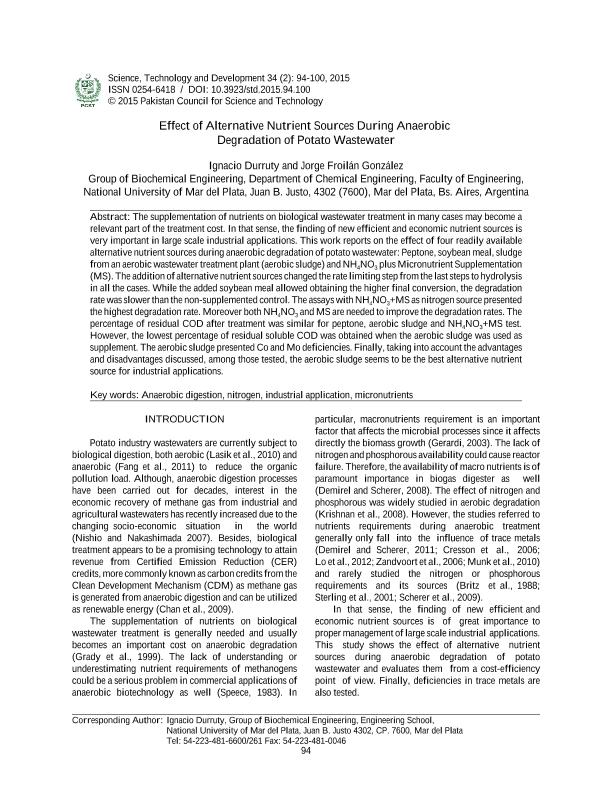Artículo
Effect of Alternative Nutrient Sources During Anaerobic Degradation of Potato Wastewater
Fecha de publicación:
06/2015
Editorial:
Pakistan Council for Science and Technology
Revista:
Science, Technology and Development
ISSN:
0254-6418
Idioma:
Inglés
Tipo de recurso:
Artículo publicado
Clasificación temática:
Resumen
The supplementation of nutrients on biological wastewater treatment in many cases may become arelevant part of the treatment cost. In that sense, the finding of new efficient and economic nutrient sources isvery important in large scale industrial applications. This work reports on the effect of four readily availablealternative nutrient sources during anaerobic degradation of potato wastewater: Peptone, soybean meal, sludgefrom an aerobic wastewater treatment plant (aerobic sludge) and NH4NO3 plus Micronutrient Supplementation(MS). The addition of alternative nutrient sources changed the rate limiting step from the last steps to hydrolysisin all the cases. While the added soybean meal allowed obtaining the higher final conversion, the degradationrate was slower than the non-supplemented control. The assays with NH4NO3+MS as nitrogen source presentedthe highest degradation rate. Moreover both NH4NO3 and MS are needed to improve the degradation rates. Thepercentage of residual COD after treatment was similar for peptone, aerobic sludge and NH4NO3+MS test.However, the lowest percentage of residual soluble COD was obtained when the aerobic sludge was used assupplement. The aerobic sludge presented Co and Mo deficiencies. Finally, taking into account the advantagesand disadvantages discussed, among those tested, the aerobic sludge seems to be the best alternative nutrientsource for industrial applications.Key words: Anaerobic digestion, nitrogen, industrial application, micronutrients
Palabras clave:
Potato Wastewater
,
Anaerobic Digestion
,
Nitrogen Sources
,
Micronutrients
Archivos asociados
Licencia
Identificadores
Colecciones
Articulos(CCT - MAR DEL PLATA)
Articulos de CTRO.CIENTIFICO TECNOL.CONICET - MAR DEL PLATA
Articulos de CTRO.CIENTIFICO TECNOL.CONICET - MAR DEL PLATA
Citación
Durruty, Ignacio; Gonzalez, Jorge Froilan; Effect of Alternative Nutrient Sources During Anaerobic Degradation of Potato Wastewater; Pakistan Council for Science and Technology; Science, Technology and Development; 34; 2; 6-2015; 94-100
Compartir
Altmétricas




